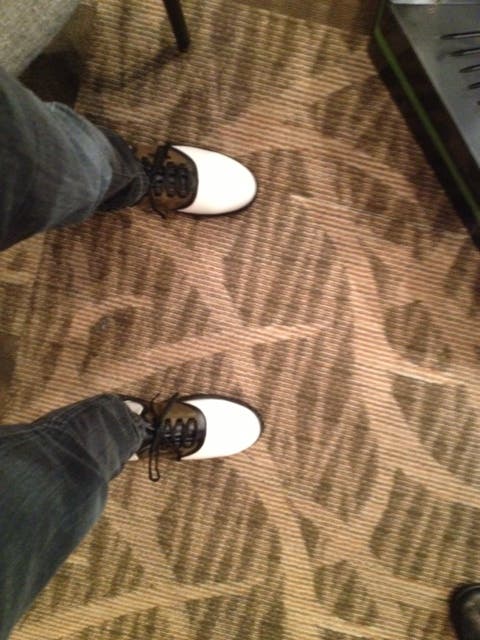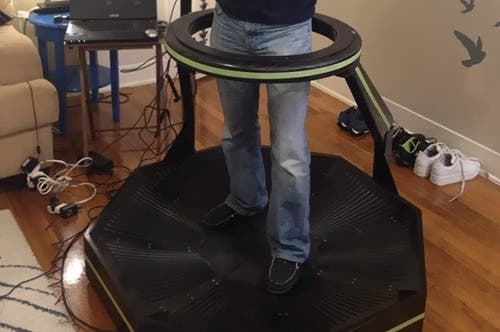Omni treadmill: The future of VR goes in every direction
Walk this way. No, not that way. THIS WAY!
In the middle of the sixth floor of the Washington State Convention Center is a man running in place inside a bowl-like surface with a plastic gun controller in his hands, motion sensors on his limbs and head, and an Oculus Rift VR headset strapped to his face. Above him, Gordon Freeman's gun bobs around a beach shooting giant alien ants. The man in the machine is controlling Valve's machine of a man - and this culmination of motion sensors, VR goggles and high-tech exercising equipment is touted as the closest man has ever come to the Matrix.
I've tried the Oculus Rift before, the motion sensors are provided by Sixense via its forthcoming STEM System motion controller that can track up to five body parts at once, but the star of the show is the Omni, Virtuix's multidirectional treadmill that raised over a million dollars on Kickstarter earlier this summer. It looks great in theory, but then again so did Kinect, and that turned out to be a much derided stop-gap on the road to the Holodeck. Would this fare any better?
The short answer is not really, but the long one is much more complicated.
Gearing up to try this high tech experiment in VR, the first thing I need to do is wear special shoes that are susceptible to the Omni's surface. These shoes have cleat-like protrusions on their soles that minimise friction and allow the player to slide freely about the apparatus. Next up someone latches Velcro straps around my ankles with Sixense sensors on them. So far, so good, but then we run into a complication.
"How tall are you?" product manager at Virtuix Colton Jacobs asks.
"Five-foot, four inches," I tell him.
"That may be a problem," he replies. "We're going to have to do this without the harness."
You see, running around inside an inverted dome isn't the most stable activity in the world. That's why the Omni comes with a safety harness that wraps around the player's waist with straps sliding under the crotch for added support. Jacobs explains that the Omni is adjustable for various heights, but it would involve a lot of unscrewing bolts and resetting up the demo station. In short, it would be too much of a production to bother with for a brief tech demo on a crowded PAX show floor. Hopefully the final version will ship with a more convenient vertical alignment.
"Omni is limited to how fast your body can turn, so there'll be games with less stimulus or having the natural body in mind. That's why we want developers to come along and think about how Omni enables much more natural movement."
product manager at Virtuix Colton Jacobs

No matter, I think. I'll just hold onto the railing by hand. This works to an extent, but it means I get a sub-optimal demo when those showing it off don't bother strapping Sixense controllers to my upper half. They also insist on handling all the shooting for me. "You look and we'll shoot," says Jacobs, trying to make the most of this inconvenient situation.
This isn't too hard of a blow to the experience, as aiming is handled by looking where you want to fire via the Oculus headset. A monitor overhead shows onlookers what I'm seeing, so ostensibly the main thing I'm missing out on is actually hitting the fire button. It's not a hard thing to imagine as I've hit plenty of buttons in my life.
I also don't have Sixense motion sensors on my arms or head. The former makes sense as my arms are going to waste, keeping myself upright in the enclosed railing, though I absentmindedly neglect to remind the demo station reps about putting a sensor on my scalp to register things like ducking. I'm too busy relearning how to walk in VR.
After all, walking - or in some cases running - is the Omni's raison d'être. And this is where things fall apart. Typically, in first-person shooters, we move via an analogue stick or by hitting the WASD keys on a keyboard. The Omni mostly gets the W down, but it struggles with ASD.
You move by placing your feet on the inclined edges of the Omni's floor, and the motion of your feet sliding back into the center of the platform causes your avatar to move. Maybe it's my vertically-challenged smaller stride or maybe it's due to me not being snuggled in place by the harness, but I have to lean forward with my stomach pressed against the railing in order to make my feet traipse along the device properly. Simply walking naturally barely seems to register.
Running is a little easier as the longer strides make my feet more susceptible to hitting the edges, but even this feels a lot less precise than using a standard controller. Much of this is due to the fact that people in first-person shooters move much differently than people in real life. We don't strafe or walk backwards, for example. Jacobs tells me that backwards movement has been disabled from the demo, and while strafing is possible, I can't get it to work because that's not how we move naturally - let alone in a somewhat persnickety high-tech VR bowl.
As such, evading a grenade that Combine soldiers toss at my feet is a much more laboured process than one might think. There's an odd bit of dissonance when my thought process immediately snaps to, "Back up! Oh wait, I can't do that. Strafe to the side! Nope, can't do that either. Quick! Spin around and run!" By the time I do this it's too late and I've been blown to bits. Game over.
"There's an odd bit of dissonance when my thought process immediately snaps to, 'Back up! Oh wait, I can't do that. Strafe to the side! Nope, can't do that either. Quick! Spin around and run!' By the time I do this it's too late and I've been blown to bits. Game over."
After this somewhat lackluster demo Jacobs tells me that "walking backwards is still a work in progress," before adding, "it absolutely will be possible". He explains that Virtuix is working to implement an instrumented base that will allow "gun separation," meaning you can run one way and shoot another. He notes that the shipped version will allow this feature.
"You won't want to strafe as much when you have gun separation because you want to be able to run one way and shoot the other way," he clarifies. "Our joke is, 'how many times have you strafed today in your natural life?' This is supposed to be mimicking natural movement."
While gun separation would help with the whole running-from-a-grenade-while-still-firing-upon-your-enemies situation, Jacobs admits that less hectic games will need to be designed for the Omni, just as Oculus is working on finding devs to create games with the Rift in mind. "Right now we can work with any PC game as all we're doing is replacing the keyboard input for movement. All that's happening when you're moving forward is hitting W on the keyboard, which makes it very simple for us. So we can port it to existing games, but we are on the lookout for developers to make games with the Omni in mind."
"In Half-Life 2 it's very fast-paced action with lots of objects and enemies coming at you at the same time. When you have a keyboard and mouse it's very easy to navigate that. You can spin around very quickly," Jacobs explains. "[Omni] is limited to how fast your body can turn, so there'll be games with less stimulus or having the natural body in mind. That's why we want developers to come along and think about how Omni enables much more natural movement."
Despite this disappointing demonstration, I still think the Omni is an intriguing prospect that shows us a glimpse of the future of VR. But if it's ever to succeed it's going to need software designed around its limitations. Merely grafting its bizarre motion control onto a game tailored for more traditional inputs regrettably ends up a literal exercise in frustration.
The Omni Treadmill is due out in January 2014 for Kickstarter backers, and March 2014 for those who pre-ordered on the official website. It costs $500, for which you get the base, ring, harness and shoes. It supports people up to 280 lbs in weight.


















